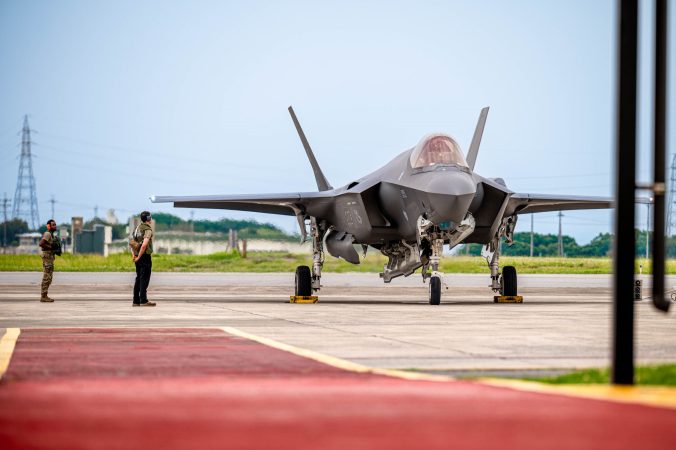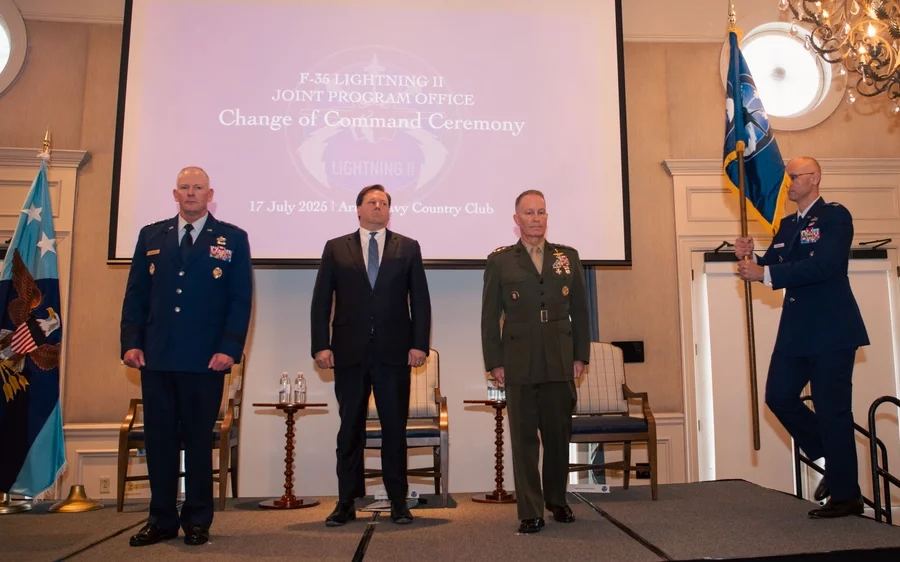Marine Corps Lt. Gen. Gregory L. Masiello has officially taken over the sprawling multiservice and multinational F-35 program. He walks into the job at what could be one of the program’s pivotal moments, as the F-35 transitions to a new configuration, scrutiny from Congress intensifies, and the Pentagon trims its budget request for new aircraft.
In a July 17 ceremony, Masiello took the F-35 guidon from Air Force Lt. Gen. Michael Schmidt, who has headed the JPO since 2022. Schmidt’s departure ends a run of six years with an Air Force officer heading the program; he succeeded Lt. Gen. Eric Fick, marking the first time in the program’s nearly 30-year history when an Air Force officer took over from another.
Masiello’s likely first order of business is to nail down the particulars of the Lots 18 and 19 production contracts. Although the JPO and Lockheed Martin have had a “handshake deal” on the two lots since last November, they have yet to announce a finalized contract that will spell out the unit cost of the three variants for the Air Force, Marine Corps, and Navy, plus international users.
There’s also been no word about whether a handshake deal has been reached with RTX’s Pratt & Whitney for the fighter’s F135 engines in those lots. The final airframe contract for Lot 18 was originally forecast for the spring, but in June the JPO said it plans to award both lots at the same time, now targeting “in summer 2025.”
Since Congress “passed a full-year continuing resolution before finalizing Lot 18, the program can now exercise the Lot 19 option alongside Lot 18 definitization,” the JPO said in June.
Lockheed Martin officials have said they believe they’re essentially finished with testing of the Tech Refresh 3 upgrade of the F-35 and that it’s ready to be used in combat, but neither the JPO nor the Pentagon’s test organization have made any announcements to that effect. The TR-3 is the foundational upgrade on which all of the Block 4 upgrades—up to 80 separate improvements—depend. The government would not accept any F-35s for nearly a year, from July 2023 to July 2024, because the jets were built with TR-3 hardware that had not yet been fully tested. More than 70 jets were stored during the delivery hold; reports indicate that the last of the backlog has now been delivered, but the JPO did not respond to Air & Space Forces Magazine queries about that.
Getting the TR-3 certified will likely be among Maiello’s top priorities.

Upgrades
Masiello will also have to manage issues with the F-35’s new radar, as the new model may require changing the mold line of the airframe. F-35s have reportedly been delivered as of late with concrete ballast in place of the new radar, until the issue is resolved. Air Force and JPO spokespersons have declined comment on whether newly delivered F-35s have a radar or counterweight in its place.
The F-35 is also getting an updated version of its engine, termed the Engine Core Upgrade. Although initial iterations of the design have been reported as successful, the project will have to be carefully managed in order to ensure that the design, development and testing go smoothy, and that the associated logistics train is ready and stocked to handle upgraded engines when they arrive.
Masiello will also have to deal with Lockheed’s ambitions—laid out by CEO Jim Taiclet in the company’s most recent earnings call—to more significantly upgrade the F-35 with enhanced stealth, sensors, and other capabilities. Taiclet suggested the new “Ferrari” version of the F-35 could be competitive with the Air Force’s F-47, the contract for which Lockheed lost to Boeing in March.
Masiello, at the change-of-command ceremony, said he looks forward “to serving with this dedicated and winning team, and I know we are ready to continue to support the U.S. and our allies with this world-class platform.”
Congress
Former White House adviser and billionaire industrialist Elon Musk frequently derided the F-35 as a vestige of what he opined was a bygone age of crewed combat aircraft and should be swiftly replaced with a new generation of AI-powered drones. While it appears his position is not widely shared, both Congress and Pentagon leadership have signaled some frustration with how the F-35 program is progressing.
In the reconciliation package passed earlier this month, money was added to a number of tactical aircraft programs, but there was none added for the F-35. Meanwhile, the fiscal 2026 budget request included only 37 F-35s, versus the 69 forecast in previous years.
House Armed Services Committee chairman Rep. Mike Rogers (R-Ala.), in an amendment adopted as part of his panel’s version of the 2026 defense policy bill, touted the importance of the F-35, noting its “stealth, situational awareness … operational flexibility” and deterrence value. But he also endorsed the Pentagon’s plan to scale back the F-35 buy and focus on readiness.
The Defense Department, Rogers wrote, “has made a strategic decision to finally prioritize funding towards sustainment and modernization, which has been under-resourced for many years to ensure the
current fleet remains combat ready and able to meet mission capability demands.” He said the committee endorses the “fight tonight” priority, particularly a boost in spare parts and reducing maintenance turnaround times.
But the amendment also endorses the “sustained procurement” of the F-35 in future years to recapitalize an aging fighter fleet.
Rogers directed the Secretaries of Defense, the Air Force, and the Navy to provide a briefing by Feb. 15, 2026, on “the future procurement ramp plan” that will produce the aircraft efficiently while also being “cost effective for broader F-35 industrial base.”
Other lawmakers also weighed in on the program. In a separate amendment, Rep. Seth Moulton (D-Mass.) said the committee “remains frustrated by ongoing delays and performance issues associated with the F-35 program,” and particularly with the TR-3 upgrade, saying that “despite the nearly yearlong delay” in taking deliveries, TR-3-configured aircraft “are not yet combat capable.” Related software has not yet been “rolled out,” he said, and the initial elements of Block 4 have been downscoped “in order to ensure the delivery of urgent needs within an acceptable timeframe.”
Given all that, the amendment directs the JPO to deliver a report by Feb. 1, 2026 assessing how well TR-3 is doing; when testing will wrap up, an updated delivery schedule, the capabilities planned for Block 4, and the schedule for their testing. The amendment also directs “a summary of the costs of the delays associated” with the TR-3 and Block 4, and how those costs will be split by Lockheed and the government.
In the Tactical Air and Land Forces subcommittee portion of the bill, Rep. Rob Wittman (R-Va.) wrote that he “supports the continued efforts to modernize the F-35 aircraft capabilities and systems but is concerned that given the program’s history of cost growth and schedule delays, continued monitoring and oversight is critical.” To that end, he directed annual reviews of the program by the Government Accountability Office.
